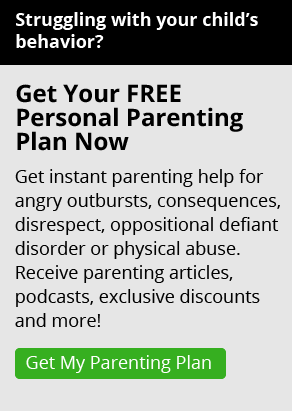When you have a child who acts out and is disrespectful or disruptive, it’s easy to compare him to the so-called “good kids” who never seem to get into trouble or give their parents grief.
Many parents feel hopeless about the possibility of ever teaching their child to become the kind of well-behaved member of the family they envisioned before they had him.
The truth is that good behavior isn’t magic. You can’t just wave a wand and turn your child into who you want him to be. Rather, good behavior is a skill that can be learned, just like carpentry, teaching, or nursing.
I believe three of the most important skills for children to learn as a foundation for good behavior are: (1) how to read social situations, (2) how to manage emotions, and (3) how to solve problems appropriately. If your child can learn to master these three tasks with your help, they will be well on their way to functioning successfully as adults.
Skill #1: Reading Social Situations
The ability to read social situations is essential. Reading social situations helps your child avoid trouble and teaches him how to get along with others. If they can walk into a classroom, lunchroom, playground, or school dance, read what’s going on there, and then decide how they’re going to interact in that environment appropriately, they’re already halfway there.
So if your child sees a bunch of kids who usually tease and bully others, the skill of reading social situations will help them stay away from that group, rather than gravitate toward it.
Parents can help their kids develop these skills by getting them to read the looks on people’s faces at the mall or a restaurant, for example.
If your child can learn to see who looks angry, frustrated, or bored, two things will happen. First, he will be able to identify how people might be feeling. And second, he’ll learn that he should try to identify other people’s emotions. Both are integral in learning how to read social situations.
Related content: Misreading Social Cues and Your Child’s Behavior
Skill #2: Managing Emotions
Your child must learn how to manage their emotions appropriately as they mature. Managing emotions means that it’s not okay to punch a hole in the wall when you’re angry. It’s not okay to curse at your dad because he took your phone away. Children need to learn that feeling angry does not give them the right to hurt others.
If your child calls his little sister a nasty name, it’s your job to sit down and ask:
“What did you see going on that you thought you needed to do that?”
Don’t ask, “How did you feel?” Instead, ask, “What was going on?”
You’ll find that this type of behavior is usually self-centered. Perhaps your child’s little sister is getting more attention. Or she’s watching a show, and he wants the TV. Or maybe she’s playing with the video games, and he wants the controller.
When your child does not know how to deal with that situation, and they become nasty or abusive, it’s time for you to step in and put a stop to it. And I think you should very clearly state:
“Just because you’re angry, it doesn’t give you the right to call your sister a nasty name.”
That’s a meaningful, direct way of teaching the skill of managing emotions.
What Giving Consequences Does (and Doesn’t) Accomplish
I believe that consequences are part of accountability. In other words, your child should know that they will be held accountable if the inappropriate behavior happens again. Consequences are important.
Nevertheless, I don’t think people change just because they’re punished or given consequences. Although parents often focus on them, consequences alone are not enough. Instead, it’s the learning process associated with the consequences that changes a child’s behavior.
So, progress is made when your child’s thinking process learns to say, “Next time I’m upset, I will get in trouble if I call Sarah a name. Instead, I should just go to my room and cool down.”
Here’s the truth: you can punish kids until the cows come home, but it’s not going to change their behavior unless the child learns to think differently. The problem lies in the faulty way kids think. This faulty thinking then gets externalized into how they behave.
If you punish your child for the behavior and neglect to challenge the way they think about the problem—or discuss their options for dealing with that problem effectively in the future—then really, what are you doing? You’re punishing your child, but he hasn’t learned anything, and he’s not going to do anything differently. Indeed, he’s probably just going to do it again when you’re not looking.
Related content: How to Give Kids Consequences That Work
Ask Your Child: “What Will You Do Differently Next Time?”
Talk to your child about what he can do differently the next time he feels angry or frustrated. This tool is something I developed as part of The Total Transformation® program, and it’s an important way to focus on changing your child’s behavior. When you use this technique, it encourages your child to come up with other things he or she might do instead of using ineffective behavior.
By the way, when you have this talk with your child, it should be a businesslike conversation. It should not be all smiley and touchy-feely. And it shouldn’t be abusive or negative, either. Just stick to the facts and ask:
“What can you do differently next time?”
And watch your body language, even if your child is angry. You want to have a neutral and businesslike body language.
Skill #3: Problem Solving
I believe that the kids labeled “good” know how to solve their problems and manage their behavior. In contrast, the kids labeled “bad” are kids who don’t know how to solve their problems. A child is often labeled “the bad kid” when he’s developed ineffective actions to solve the problems that other kids solve appropriately.
So this child may turn to responses that are disrespectful, destructive, abusive, and physically violent. In my opinion, there’s no such thing as good kids or bad kids. There are simply kids who have learned effective ways of solving life’s problems, and kids who have not.
As they develop, children have to continually adjust their problem-solving skills and learn new ones. For instance, for a three-year-old, being told “no” is the biggest problem in her life. They stomp their feet and throw a tantrum. Eventually, they have to learn to deal with that problem and manage the feelings associated with it.
For five-year-olds, the problem may be dealing with the first day of school. For nine-year-olds, the problem may be dealing with a bully. And for 12- and 13-year-olds, when they’re at middle school, they’re presented with a more chaotic environment than they’ve ever faced before.
You Can’t Wish Away Bad Child Behavior
I’ve devoted much of my career to dealing with kids who behave inappropriately, all the way from kids who were withdrawn and depressed to kids who were aggressive and acted out physically. I believe a key element in helping children change their behavior is for parents to learn techniques to help their child identify the problem they’re facing.
Together, you look at how to solve problems and come up with appropriate and effective solutions—solutions that won’t get them into further trouble. So, talk to your child about the problem at hand and how to solve it—not just about the emotion your child is feeling.
In the end, there is no magic solution to good behavior. The secret is really in teaching kids how to solve problems. Good behavior is simply one of the fruits of that problem-solving tree.
Your goal as a parent is to give your child the tools to learn good behavior. It’s never too late to get these tools.
But know this: if your teenager can’t read a social situation, responds inappropriately, reacts by getting aggressive, and then gets into trouble, how do you think they’re going to handle it when they’re an adult and their boss tells them something they don’t want to hear? How will they manage personal relationships?
That’s why it’s essential for you as the parent not to wish away the bad behavior and to start teaching your child the skills they need to change their behavior for good.
Related Content:
Challenging Parenting Issues: 5 of the Hardest Things Parents Face
Do You Stay Mad at Your Kids and Hold a Grudge When They Misbehave? (How It Can Backfire on You)
About James Lehman, MSW
James Lehman, who dedicated his life to behaviorally troubled youth, created The Total Transformation®, The Complete Guide to Consequences™, Getting Through To Your Child™, and Two Parents One Plan™, from a place of professional and personal experience. Having had severe behavioral problems himself as a child, he was inspired to focus on behavioral management professionally. Together with his wife, Janet Lehman, he developed an approach to managing children and teens that challenges them to solve their own problems without hiding behind disrespectful, obnoxious or abusive behavior. Empowering Parents now brings this insightful and impactful program directly to homes around the globe.
You must log in to leave a comment. Don't have an account? Create one for free!



